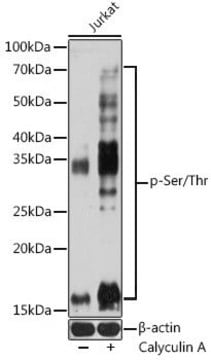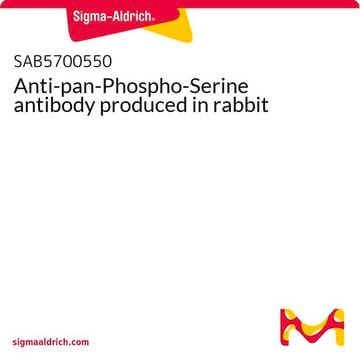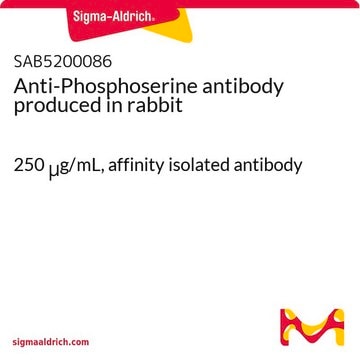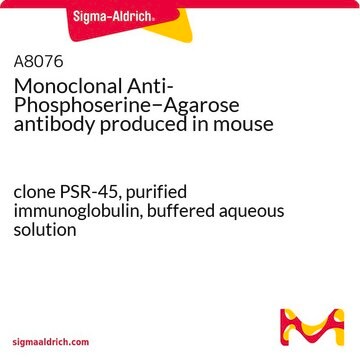AB1603
Anti-Phosphoserine Antibody
Chemicon®, from rabbit
Sinónimos:
Anti-Phospho Serine Antibody, Phosphorylation Inhibitor
About This Item
Productos recomendados
biological source
rabbit
Quality Level
antibody form
affinity isolated antibody
antibody product type
primary antibodies
clone
polyclonal
purified by
affinity chromatography
species reactivity (predicted by homology)
all
manufacturer/tradename
Chemicon®
technique(s)
ELISA: suitable
immunohistochemistry: suitable
immunoprecipitation (IP): suitable
western blot: suitable
shipped in
wet ice
target post-translational modification
phosphorylation (pSer)
General description
Specificity
Immunogen
Application
10-20 μg anti-pS/mg protein was used from a previous lot.
Note that this will immunoprecipitate all phosphoserine proteins in the extracts. If using purified protein exacts containing only the protein of interest, antibody amounts should be decreased to 5 μg/500 μL of extracts. Optimal concentrations must be determined experimentally.
ELISA (kinase assay):
A previous lot of this anitbody was used at a 1:250-1:500 dilution.
Immunohistochemistry:
A previous lot of this antibody was used at a 1:50 dilution.
As the antibody detects all phosphoserines, any phosphorylated serine protein or peptide can be used to block antibody staining.
Typically a 10 M excess of peptide is used in Tris based buffers.
Western Blot Analysis:
1:500 dilution of a previous lot
Optimal working dilutions must be determined by end user.
Signaling
General Post-translation Modification
Quality
Western Blot Analysis: 1:500 dilution of this lot detected serine phosphorylated proteins on 10 μg of NGF treated PC12 lysates.
Target description
Physical form
Storage and Stability
Analysis Note
NIH 3T3 cells (+/- TPA), K562 cells, and EGF-stimulated A431 cells.
Other Notes
Legal Information
Disclaimer
Not finding the right product?
Try our Herramienta de selección de productos.
Storage Class
12 - Non Combustible Liquids
wgk_germany
WGK 2
flash_point_f
Not applicable
flash_point_c
Not applicable
Certificados de análisis (COA)
Busque Certificados de análisis (COA) introduciendo el número de lote del producto. Los números de lote se encuentran en la etiqueta del producto después de las palabras «Lot» o «Batch»
¿Ya tiene este producto?
Encuentre la documentación para los productos que ha comprado recientemente en la Biblioteca de documentos.
Nuestro equipo de científicos tiene experiencia en todas las áreas de investigación: Ciencias de la vida, Ciencia de los materiales, Síntesis química, Cromatografía, Analítica y muchas otras.
Póngase en contacto con el Servicio técnico








